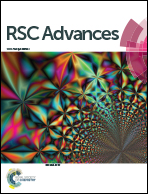Mechanical properties of structurally-defined magnetoactive polymer (co)networks†
Abstract
The mechanical properties of structurally-defined magnetoactive polymer (co)networks synthesized from well-defined poly(2-dimethylamino)ethyl methacrylate (poly(DMAEMA)) homopolymers and diblock copolymers of poly(DMAEMA) with the hydrophobic n-butyl methacrylate (BuMA) were measured in compression. Magnetic nanoparticle composition varied from 0 to 30% wt and caused a 6-fold increase in the Young's modulus of the homopolymer networks (2.91 vs. 18.62 kPa) and a 12-fold increase in the modulus of diblock copolymer networks (0.76 vs. 9.1 kPa), with homopolymers being stiffer. Mathematical modeling revealed an exponential constitutive equation to predict accurately the mechanical response of the polymers. Furthermore, experiments were performed for the poroelastic behavior of the materials and their hydraulic conductivity was found to be independent of magnetic loading and network structure. In conclusion, the incorporation of magnetic nanoparticles strengthened the (co)network structure, while the synthetic approach employed for the DMAEMA-b-BuMA formation retained the linear, non-crosslinked architecture of BuMA, resulting in less stiff structures.


 Please wait while we load your content...
Please wait while we load your content...